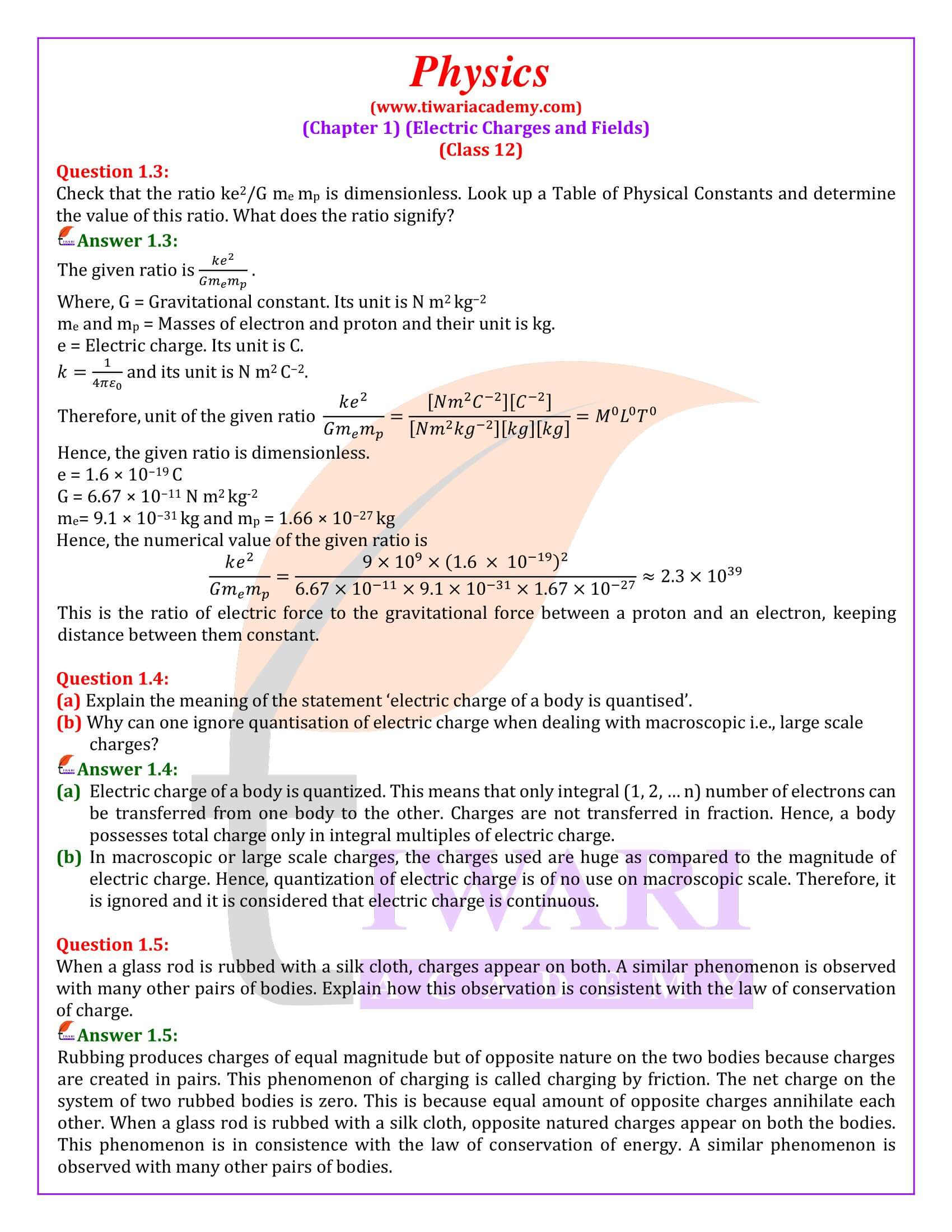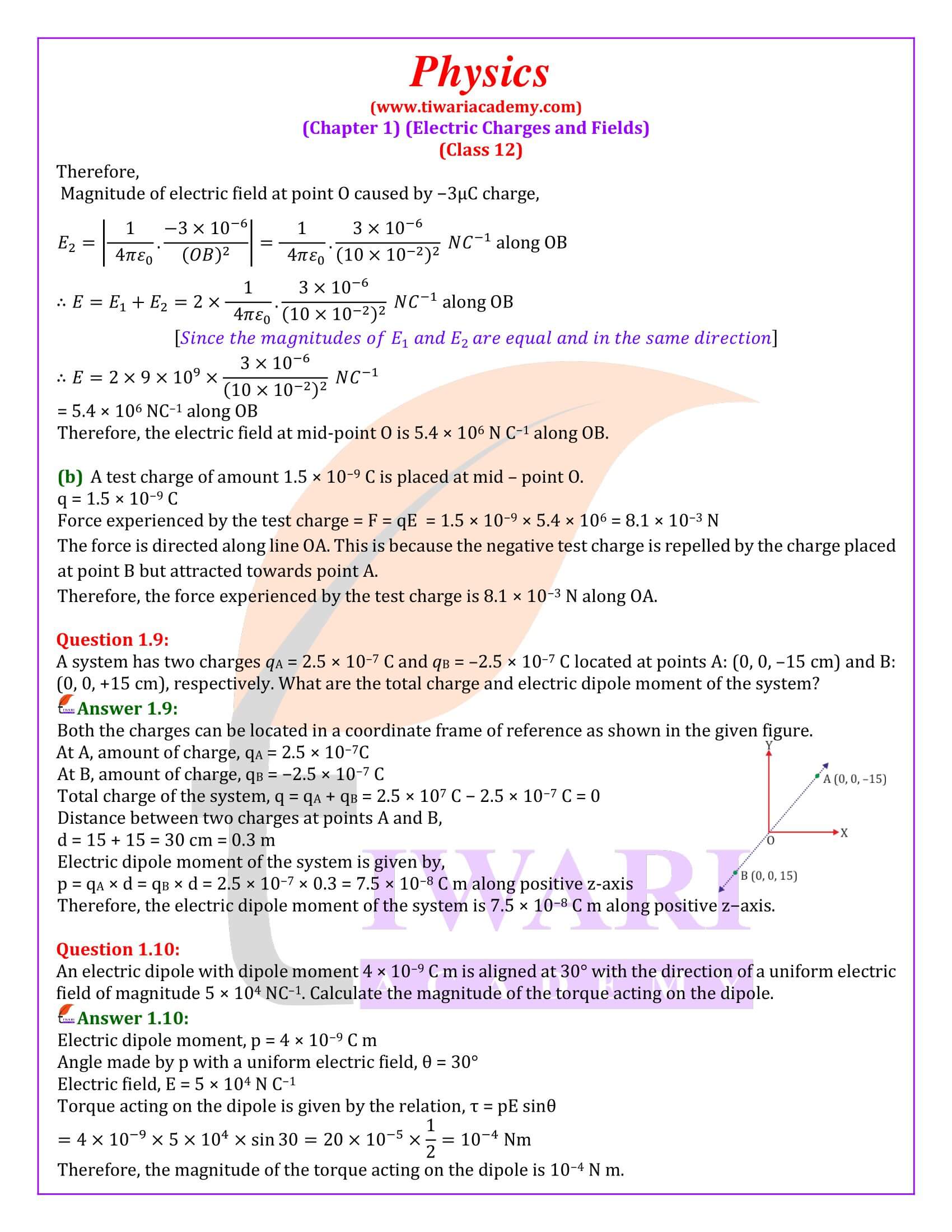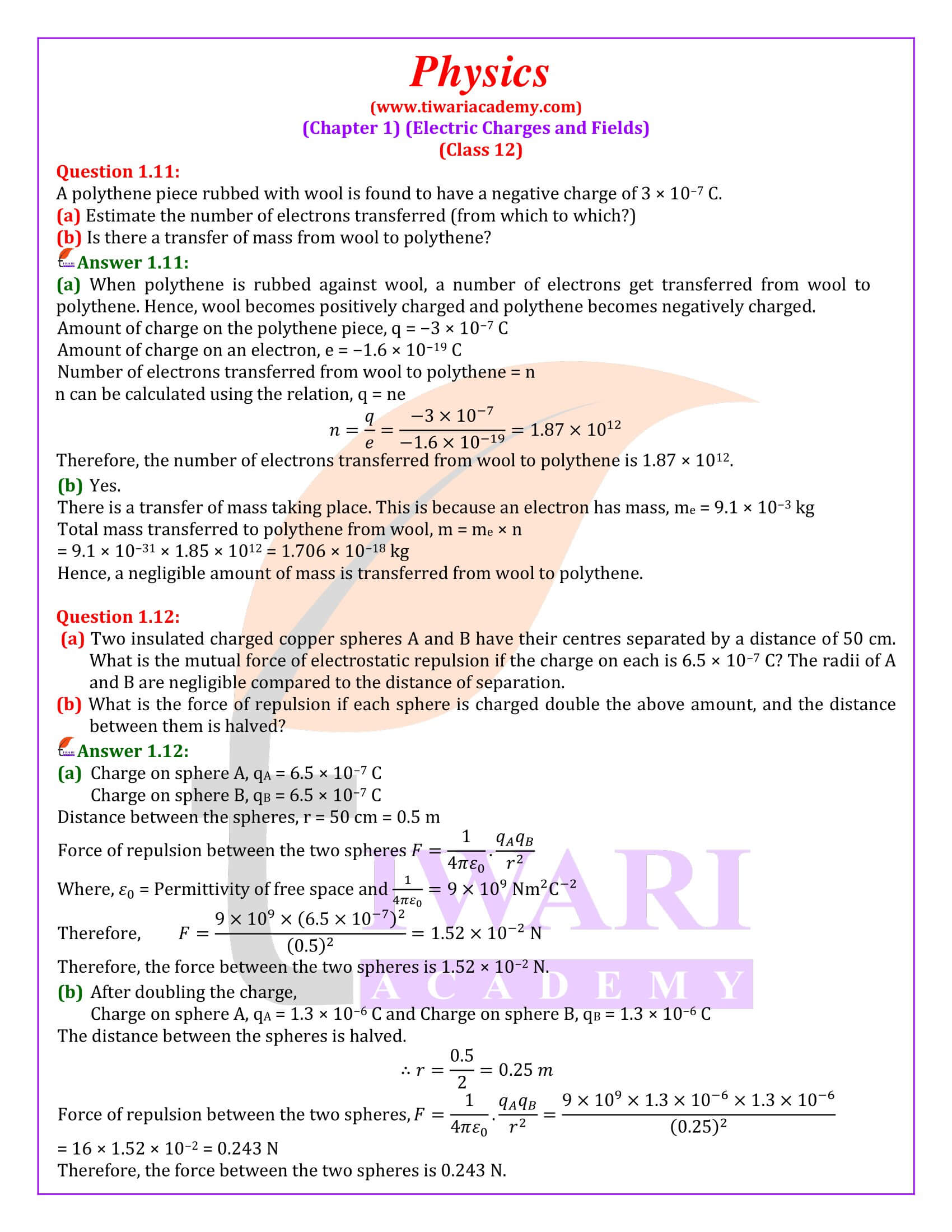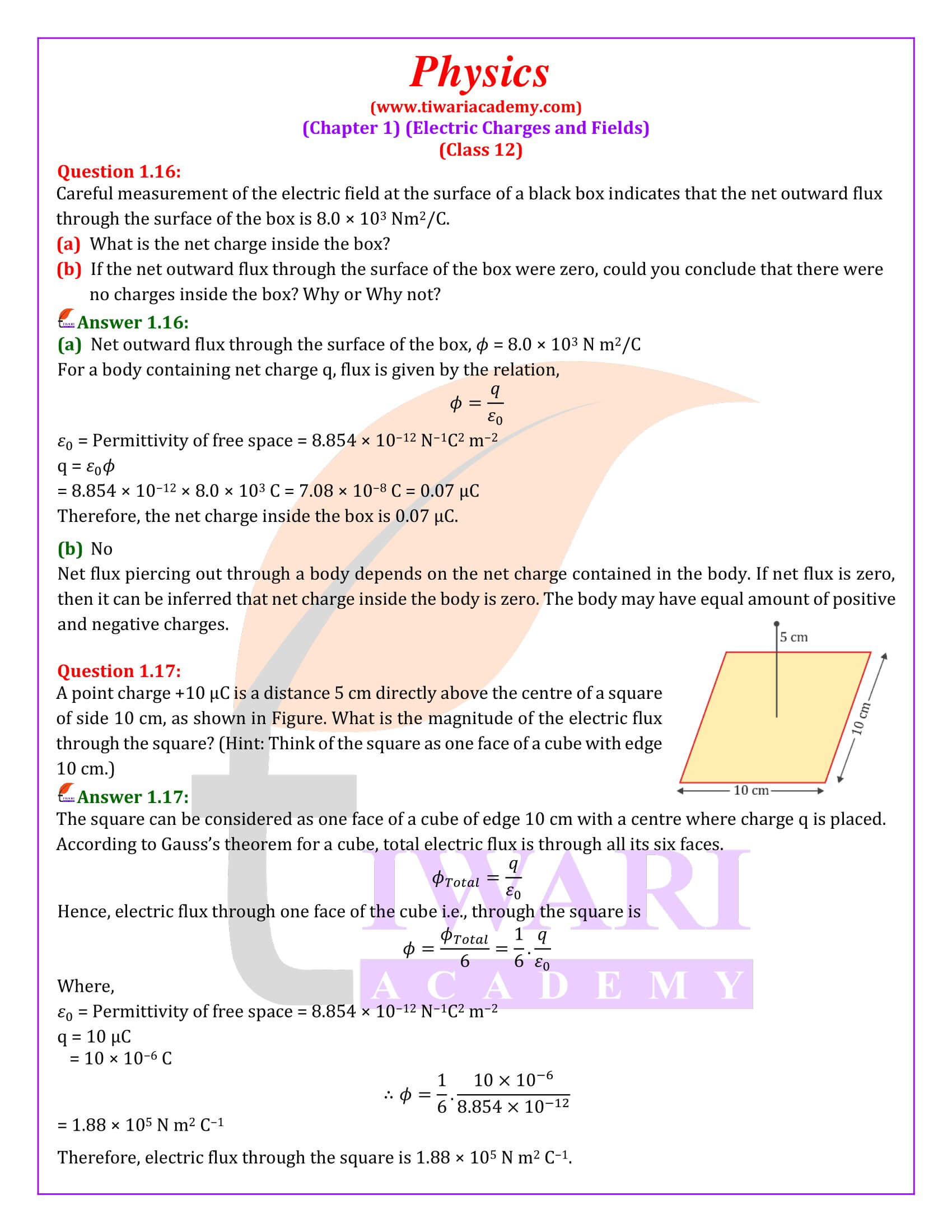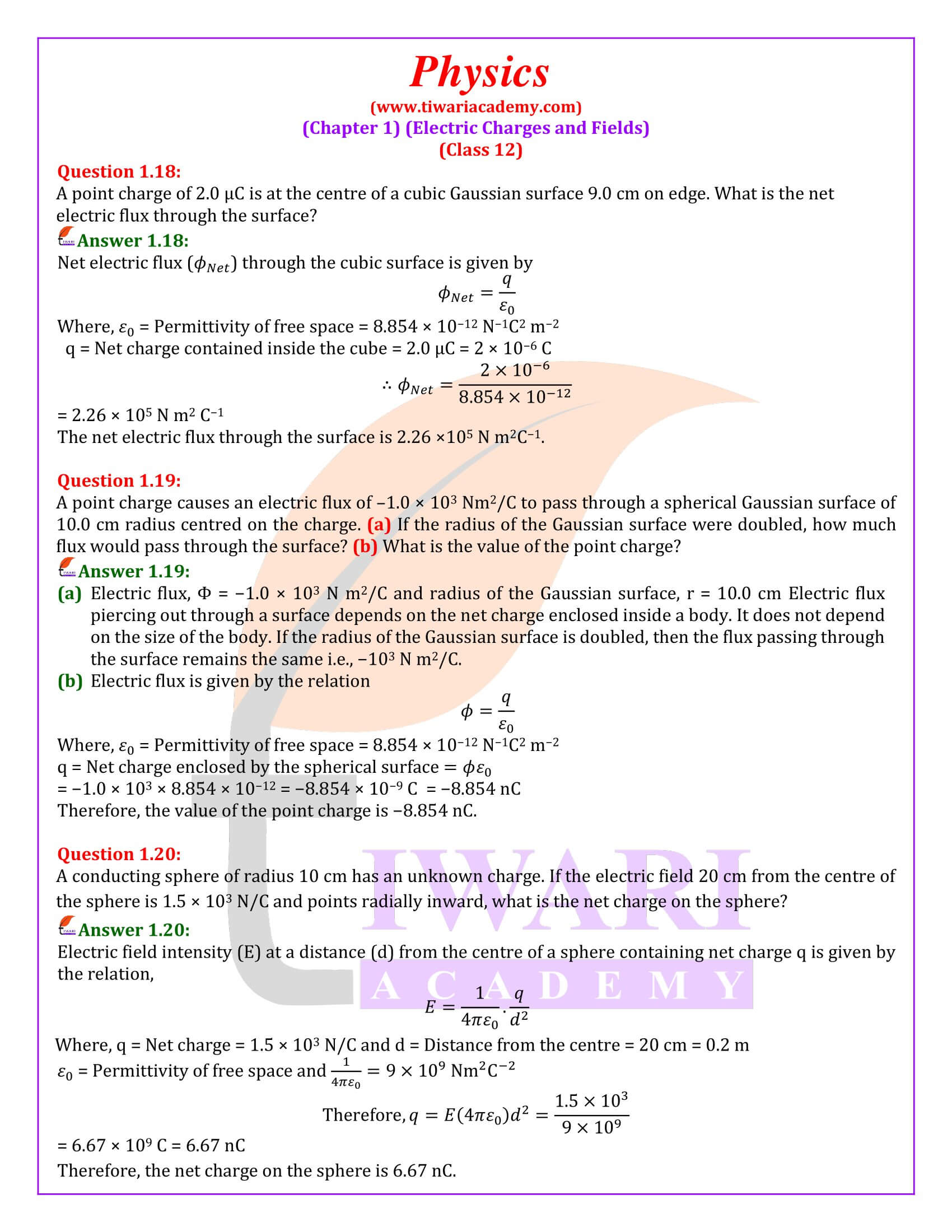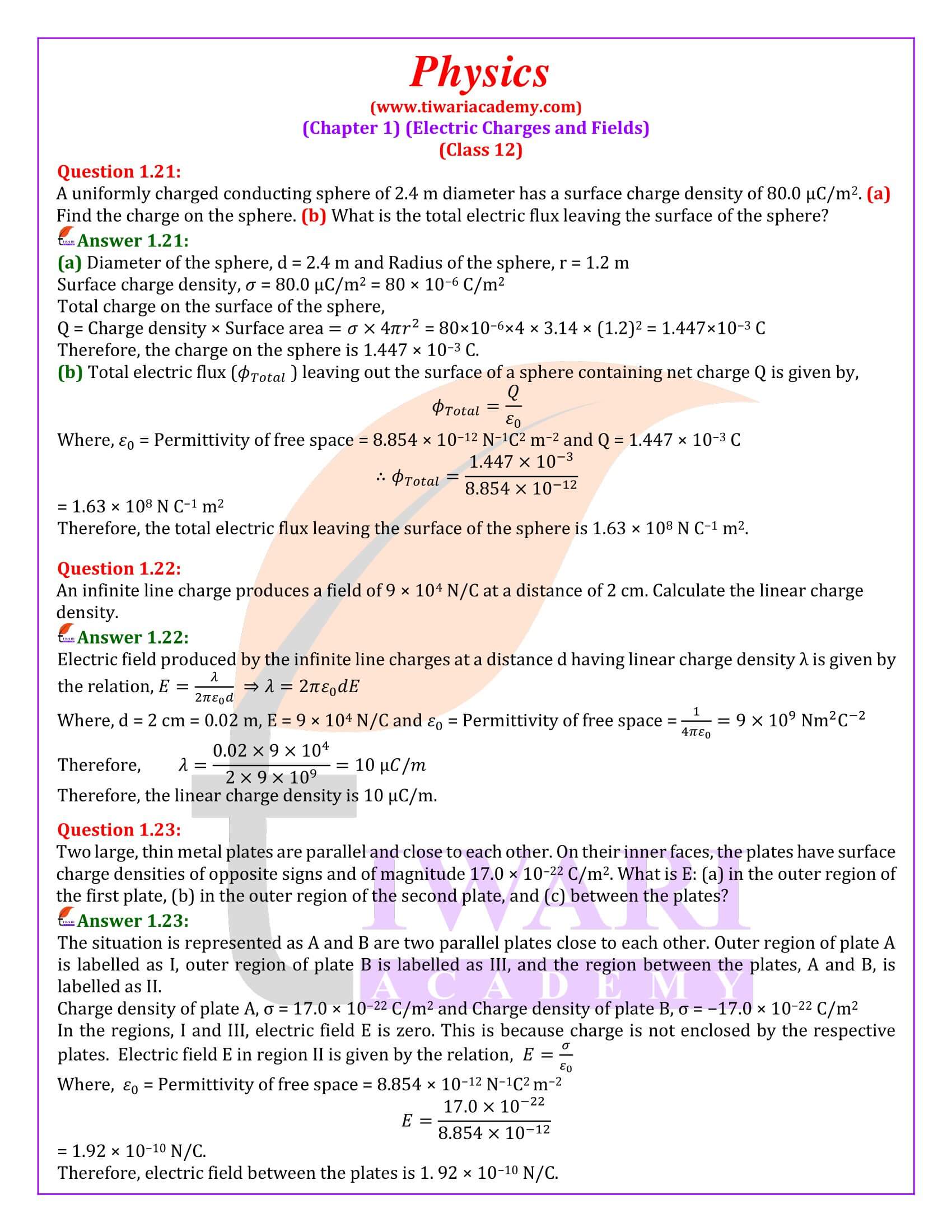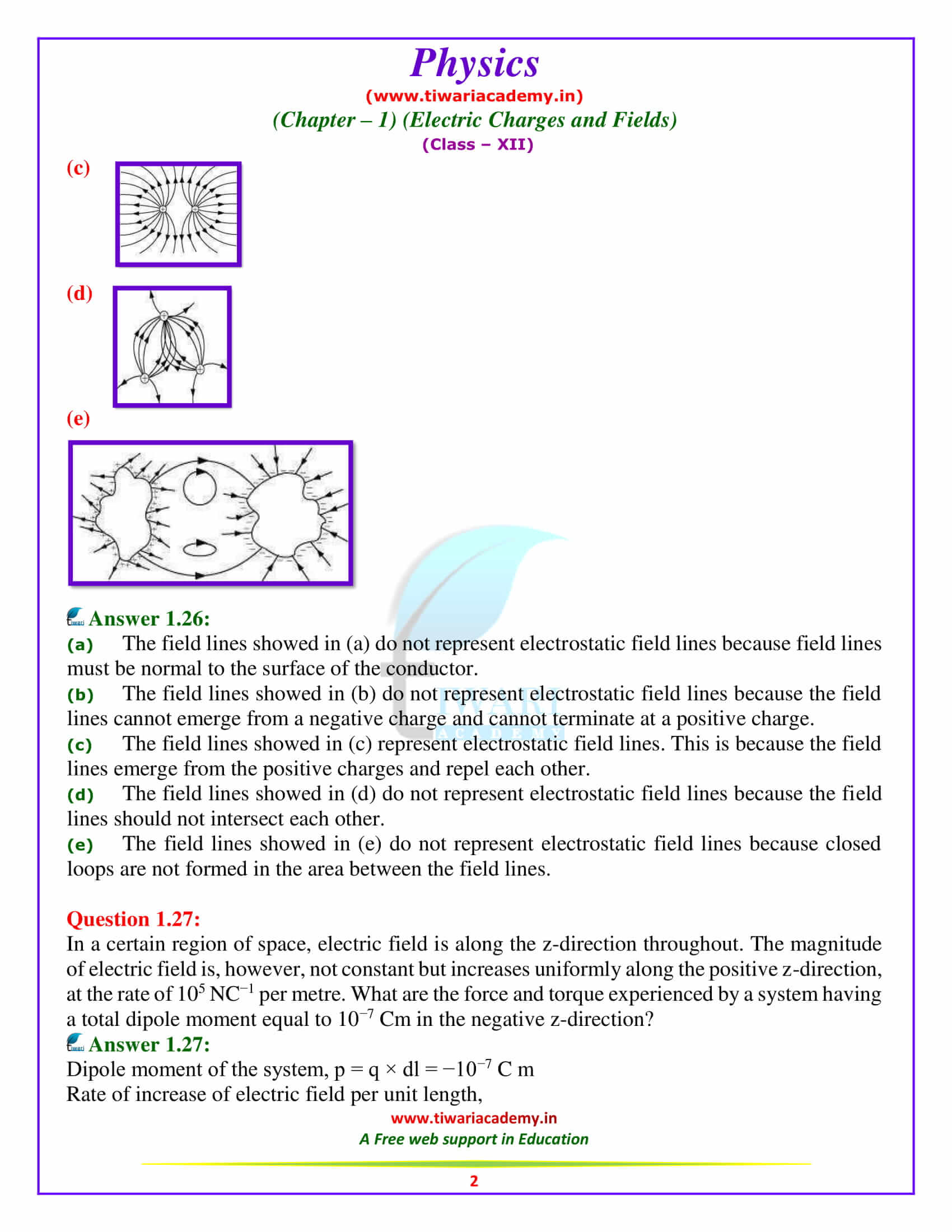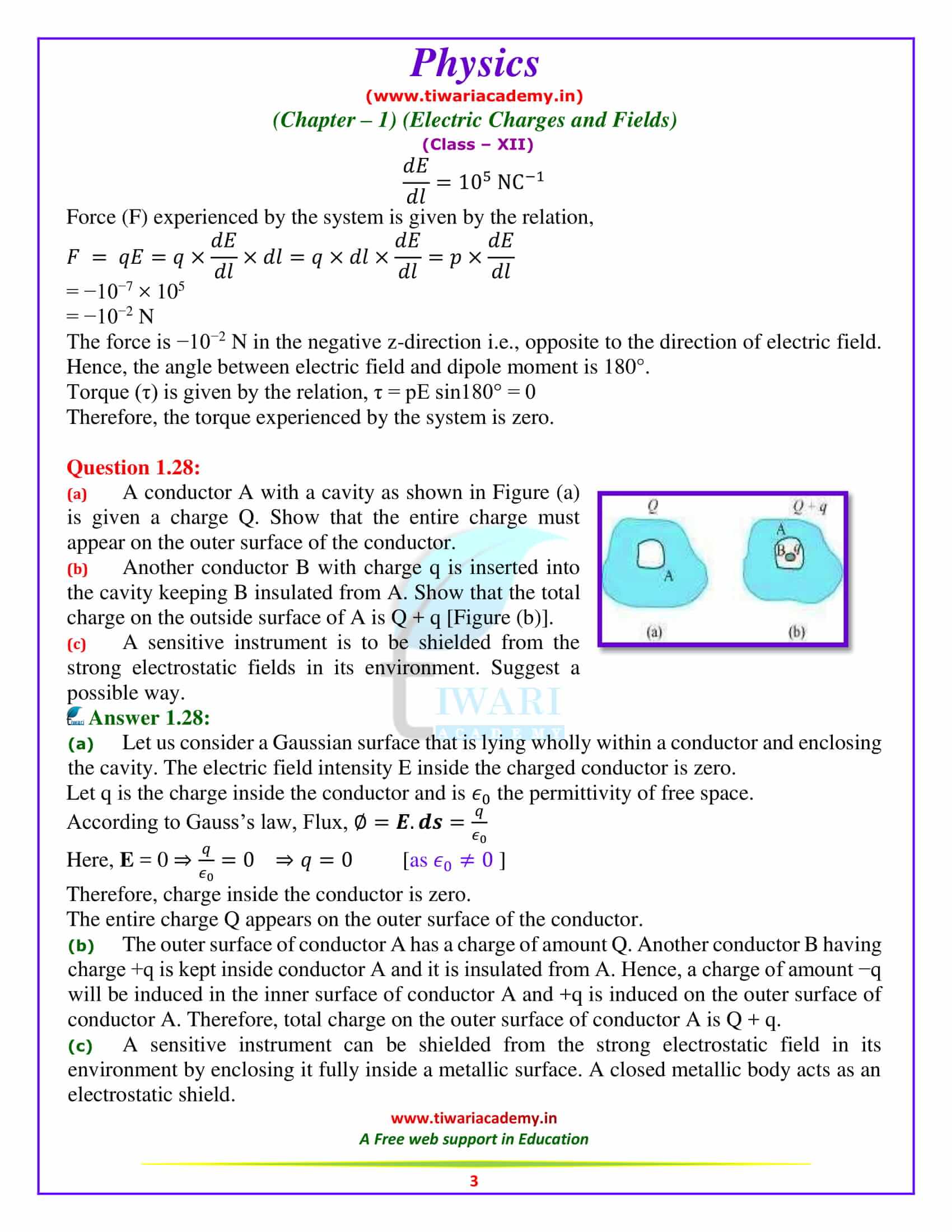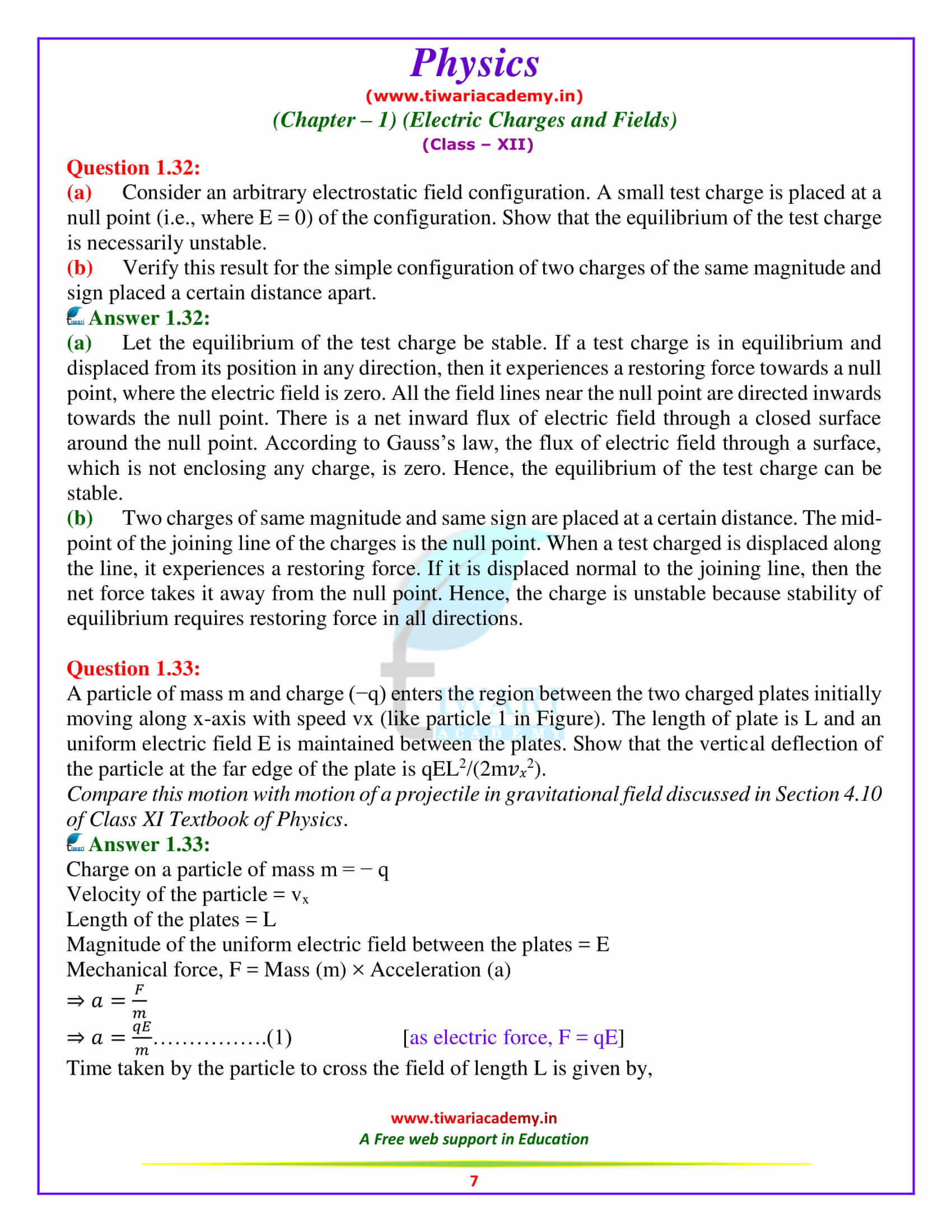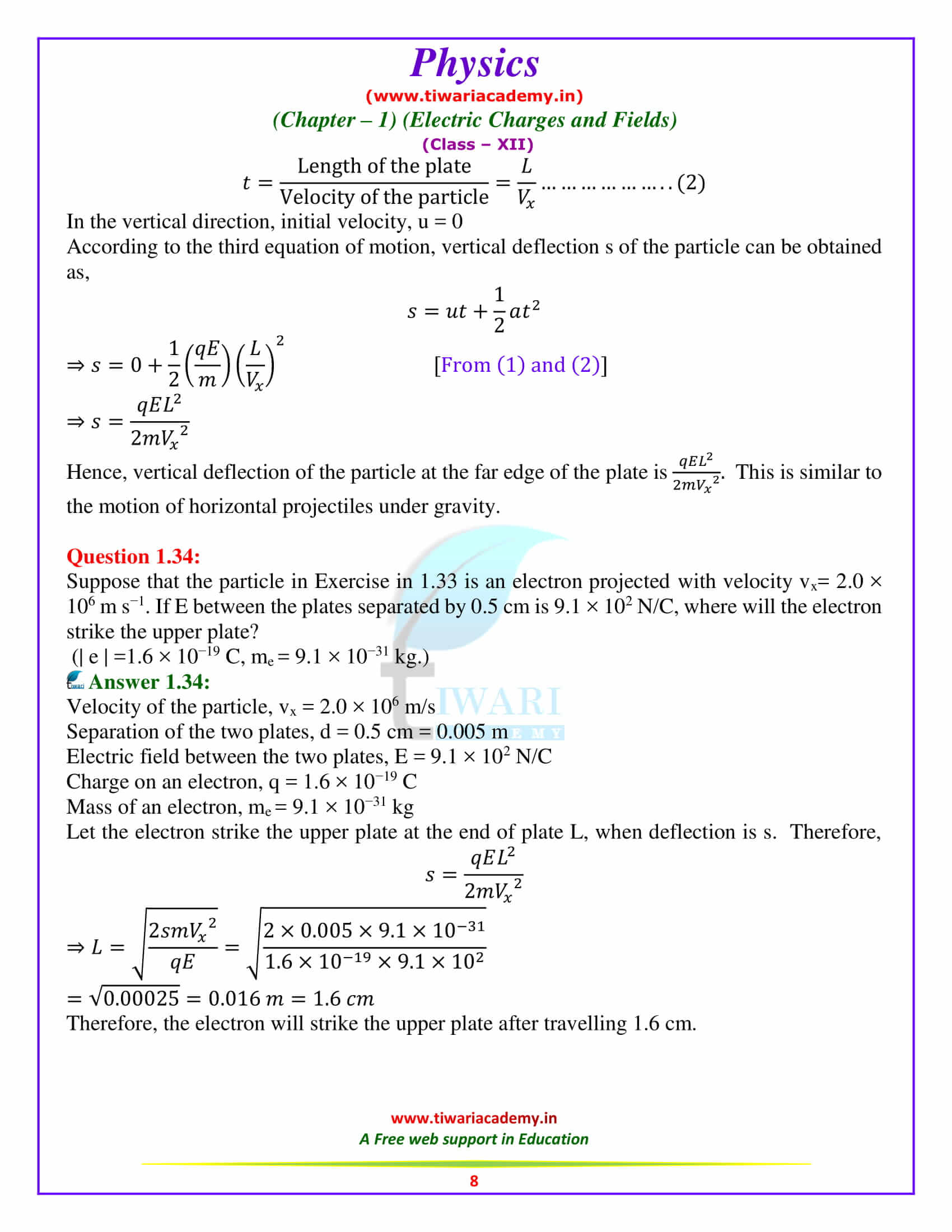NCERT Solutions for Class 12 Physics Chapter 1 Electric Charges and Fields Updated for New Session 2025-26 in Hindi and English Medium PDF study online through the solutions. Question answers of chapter 1 are modified as per NCERT textbooks published for academic year 2025-26. The Additional Exercises questions are now deleted from the syllabus.
Class 12 Physics Chapter 1 Electric Charges and Fields Solutions
- Class 12 Physics Chapter 1 Exercises Solutions
- 12th Physics Chapter 1 Additional Exercises (Not in Syllabus)
- Class 12 Physics Chapter 1 Solutions in Hindi
- Class 12 Physics NCERT Book Chapter 1
- Class 12 Physics Revision Book Chapter 1
- Revision Book Answers
- Class 12 Physics Chapter 1 Revision Notes 1
- Class 12 Physics Chapter 1 Revision Notes 2
- Download Class 12 Physics Chapter 1 Quick Revision
- Download Class 12 Physics Chapter 1 Revision Questions
- Visit to 12th Physics Main Page
NCERT Class 12 Physics Chapter 1 Solutions
Download UP Board Solutions for Class 12 Physics Chapter 1 revised and updated for academic session based on new textbooks published in 2025-26.
Viva Voice for Class 12 Physics
How to Prepare for Class 12 Physics Exam
Study Tips for Class 12 CBSE Board
| Class: 12 | Physics |
| Topic Name: | Electric Charges and Fields |
| Session: | CBSE 2025-26 |
| Content: | NCERT Solutions and Study Material |
| Medium: | Hindi and English Medium |
Class 12 Physics Chapter 1 Solutions in English
NCERT Solutions for Class 12 Physics Chapter 1 in PDF format are given below to free download updated for new academic session 2025-26. Join the Discussion Forum to ask your doubts related to CBSE or NIOS board. Download Offline Apps based on latest NCERT Books 2025-26 following the new CBSE Syllabus 2025-26.
12th Physics Chapter 1 Questions from Board Papers
1. Net capacitance of three identical capacitors connected in parallel is 12 microfarad. What will be the net capacitance when two of them are connected in (i) parallel (ii) series?
2. A charge Q is distributed over a metal sphere of radius R. What is the electric field and electric potential at the centre? Answer: E = 0, V = kQ/R.
3. Write the ratio of electric field intensity due to a dipole at a point on the equatorial line to the field at a point at a point on the axial line, when the points are at the same distance from the centre of dipole.
4. An uncharged conductor A placed on an insulating stand is brought near a charged insulated conductor B. What happens to the charge and potential of B?
5. Why is the potentiometer preferred to a voltmeter for measuring emf of a cell?
Important Questions for practice
1. In an uniform electric field of strength E, a charged particle Q moves point A to point B in the direction of the field and back from B to A. Calculate the ratio of the work done by the electric field in taking the charge particle from A to B and from B to A.
2. How does the relaxation time of electron in the conductor change when temperature of the conductor decreases.
3. A copper wire of resistance R is uniformly stretched till its length is increased to n times its original length. What will be its new resistance?
4. A car battery is of 12V. Eight dry cells of 1.5 V connected in series also give 12V, but such a combination is not used to start a car. Why?
5. An oil drop of mass m carrying charge –Q is to be held stationary in the gravitational field of the earth. What is the magnitude and direction of the electrostatic field required for this purpose? Answer: E = mg/Q, downward.
Important Questions on 12th Physics Chapter 1
Explain the meaning of the statement ‘electric charge of a body is quantised’.
Electric charge of a body is quantized. This means that only integral (1, 2, …., n) number of electrons can be transferred from one body to the other. Charges are not transferred in fraction. Hence, a body possesses total charge only in integral multiples of electric charge.
Why can one ignore quantisation of electric charge when dealing with macroscopic i.e., large scale charges?
In macroscopic or large scale charges, the charges used are huge as compared to the magnitude of electric charge. Hence, quantisation of electric charge is of no use on macroscopic scale. Therefore, it is ignored and it is considered that electric charge is continuous.
When a glass rod is rubbed with a silk cloth, charges appear on both. A similar phenomenon is observed with many other pairs of bodies. Explain how this observation is consistent with the law of conservation of charge.
Rubbing produces charges of equal magnitude but of opposite nature on the two bodies because charges are created in pairs. This phenomenon of charging is called charging by friction. The net charge on the system of two rubbed bodies is zero. This is because equal amount of opposite charges annihilate each other. When a glass rod is rubbed with a silk cloth, opposite nature charges appear on both the bodies. This phenomenon is in consistence with the law of conservation of energy. A similar phenomenon is observed with many other pairs of bodies.
An electrostatic field line is a continuous curve. That is, a field line cannot have sudden breaks. Why not?
Electrostatic field line is a continuous curve because a charge experiences a continuous force when traced in an electrostatic field. The field line cannot have sudden breaks because the charge moves continuously and does not jump from one point to the other.
Explain why two field lines never cross each other at any point?
If two field lines cross each other at a point, then electric field intensity will show two directions at that point. This is not possible. Hence, two field lines never cross each other.
What is the net flux of the uniform electric field of Exercise 1.15 through a cube of side 20 cm oriented so that its faces are parallel to the coordinate planes?
All the faces of a cube are parallel to the coordinate axes. Therefore, the number of field lines entering the cube is equal to the number of field lines piercing out of the cube. As a result, net flux through the cube is zero.
Consider an arbitrary electrostatic field configuration. A small test charge is placed at a null point (i.e., where E = 0) of the configuration. Show that the equilibrium of the test charge is necessarily unstable.
Let the equilibrium of the test charge be stable. If a test charge is in equilibrium and displaced from its position in any direction, then it experiences a restoring force towards a null point, where the electric field is zero. All the field lines near the null point are directed inwards towards the null point. There is a net inward flux of electric field through a closed surface around the null point. According to Gauss’s law, the flux of electric field through a surface, which is not enclosing any charge, is zero. Hence, the equilibrium of the test charge can be stable.
Verify this result for the simple configuration of two charges of the same magnitude and sign placed a certain distance apart.
Two charges of same magnitude and same sign are placed at a certain distance. The mid-point of the joining line of the charges is the null point. When a test charged is displaced along the line, it experiences a restoring force. If it is displaced normal to the joining line, then the net force takes it away from the null point. Hence, the charge is unstable because stability of equilibrium requires restoring force in all directions.

